| کد مقاله | کد نشریه | سال انتشار | مقاله انگلیسی | نسخه تمام متن |
|---|---|---|---|---|
| 2584982 | 1561772 | 2014 | 11 صفحه PDF | دانلود رایگان |

• At levels of exposure seen with human use, DEGEE is well established as a safe vehicle and solvent by multiple routes.
• Toxicity seen in older DEGEE studies is likely due to significant amounts of impurities including ethylene glycol.
• At high levels of exposure, the target organ of toxicity is the kidney.
Transcutol® (Diethylene glycol monoethyl ether, DEGEE), CAS # 111-90-0, is commonly used as a vehicle in the formulation or manufacturing process of pharmaceuticals, cosmetics, and food additives. This paper presents unpublished nonclinical safety data using a form of DEGEE which includes a significantly decreased level of impurities, specifically ethylene glycol and diethylene glycol. It also reviews the history of use, regulatory status, and previously published toxicity data for DEGEE. The review supports that DEGEE is well tolerated across animal species and gender with toxicity occurring only at levels well above those intended for human use. At high levels of exposure, the kidney is identified as the critical target organ of DEGEE toxicity. DEGEE is negative for genotoxicity in in vitro and in vivo studies. Subchronic and chronic toxicity studies produced no reports of preneoplastic changes in organs, but the animal data is insufficient to allow a definitive opinion as to carcinogenicity. In silico data suggested that DEGEE is not carcinogenic or genotoxic. Developmental toxicity was seen in rats but only at levels 200 times greater than the estimated oral Permissible Daily Exposure Level of 10 mg/kg/day. The nonclinical data along with the long history of DEGEE use as a vehicle and solvent by multiple routes provide evidence of its safety. Furthermore, the novel data discussed herein provides evidence that toxicity previously associated with high levels of DEGEE in nonclinical studies conducted prior to 1990 could possibly be attributed to the presence of significant amounts of ethylene glycol or other impurities.
Journal: Food and Chemical Toxicology - Volume 72, October 2014, Pages 40–50